This is the website of Abulsme Noibatno Itramne (also known as Sam Minter).
Posts here are rare these days. For current stuff, follow me on Mastodon
|
The Iowa caucuses have finally come and gone, and we have the first “earned” delegate results of the nomination race. Sorta. No actual Democratic delegates were actually determined. It was just the first step in a multi stage process. But as of now, estimates can be made. The estimates as per The Green Papers are 23 delegates for Clinton and 21 for Sanders. There were also 4 Iowa superdelegates already for Clinton.
So the Iowa totals as of this post are: 27 Clinton, 21 Sanders, 4 superdelegates TBD.
Even if all 4 remaining superdelegates went for Sanders, which is unlikely, Clinton still wins Iowa 27 to 25.
This despite the predominant reporting of tonight’s results as a tie or near-tie for Sanders.
In addition, since my last post on the Democrats in other states there have been 3 additional super delegates who came out for Clinton, and 2 who came out for Sanders.
So, where does that put us? First, the raw delegate totals:
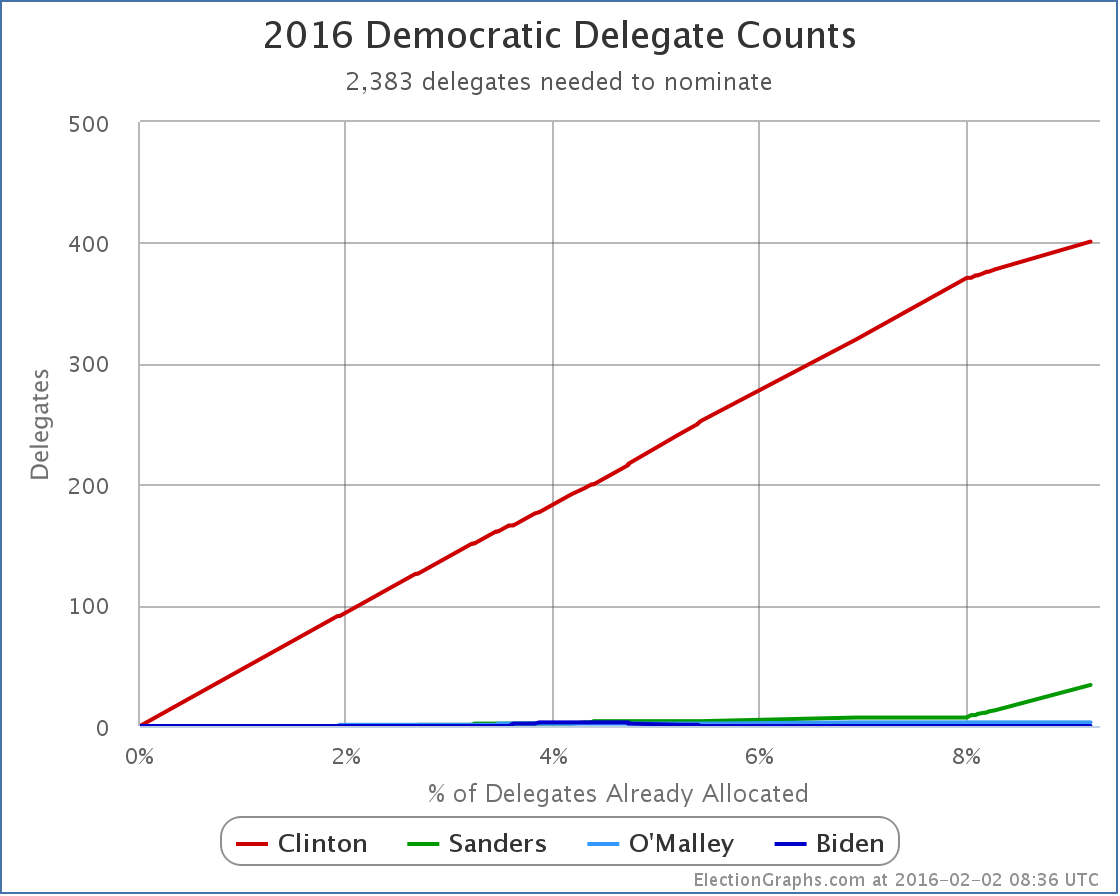
You can see the “kink” in the chart that is the result of Clinton getting a much smaller percentage of the Iowa delegates than her absolute domination in the superdelegate race. This of course means her percentage of the delegates so far takes a bit of a swoon:
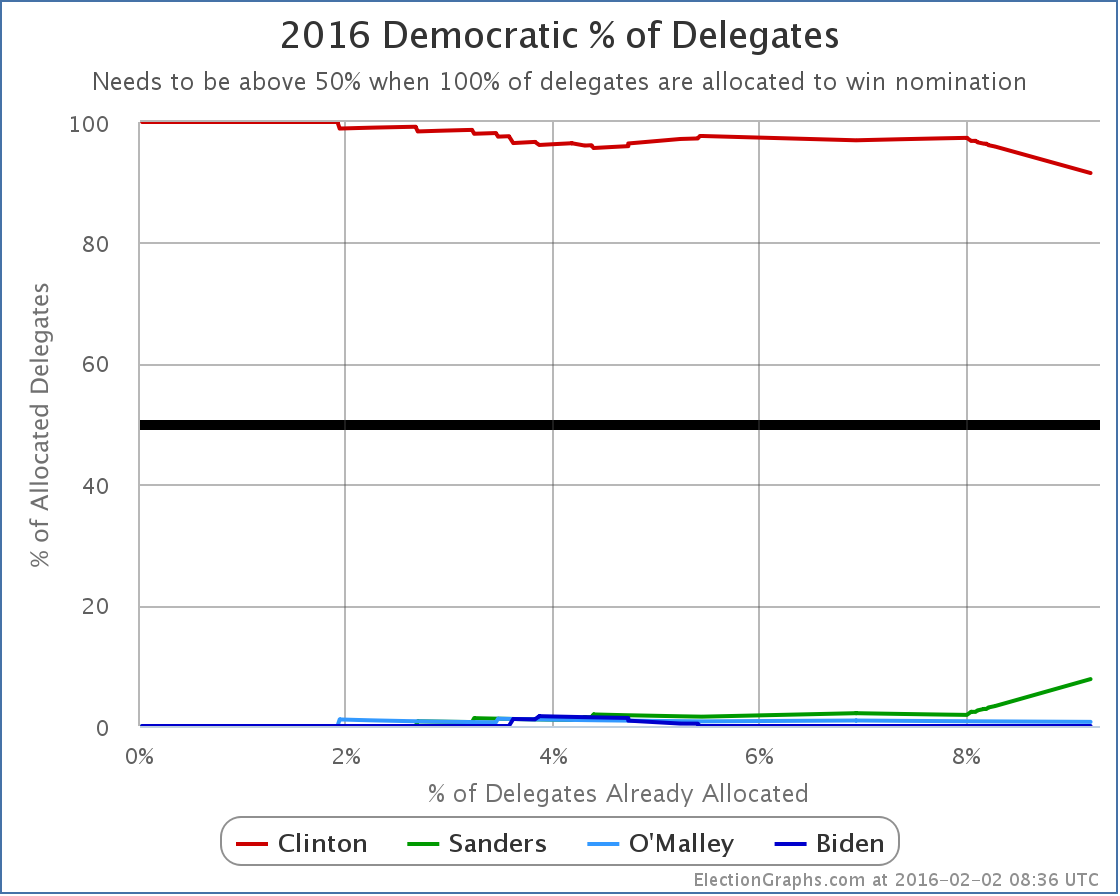
Clinton is down to only 91.55% of the delegates allocated so far! That’s the lowest she has been so far!
OK, that is down, but actually it is still pretty dominant.
But what does all this do to the critical “% of remaining delegates needed to win”?
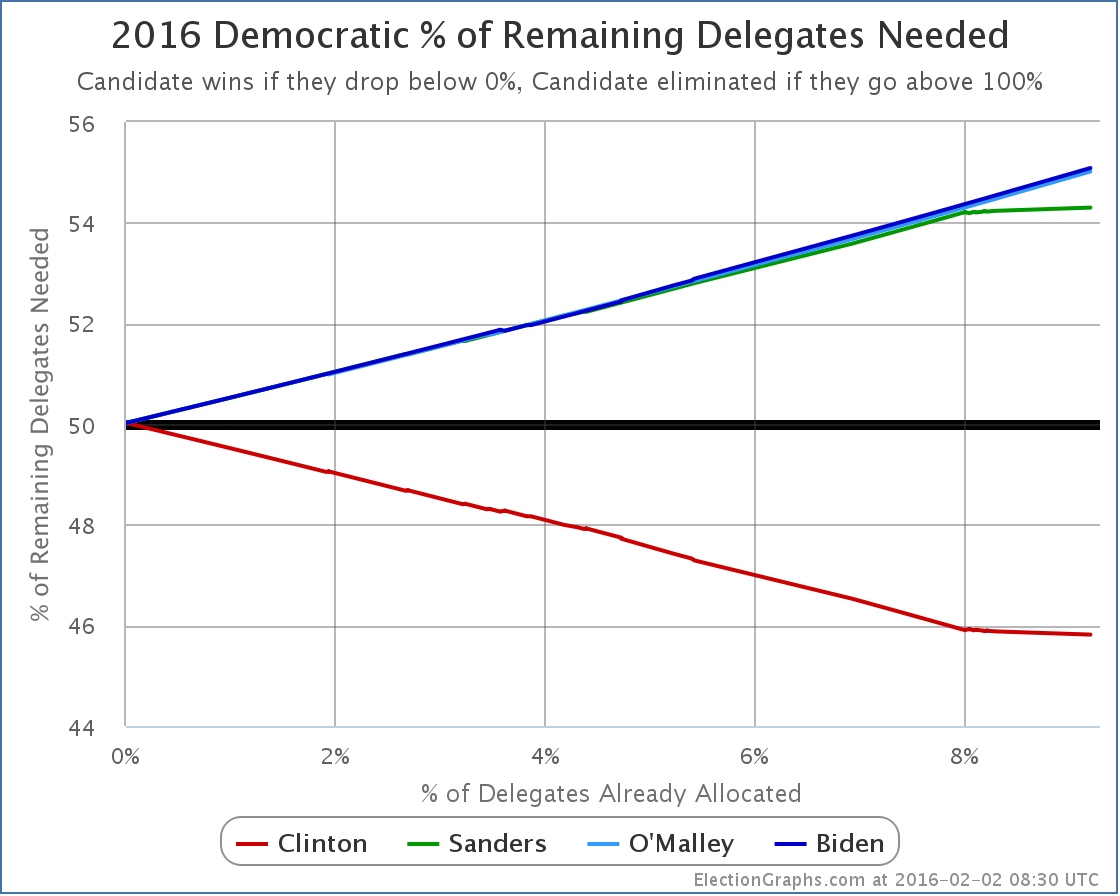
When I made the last blog update, Sanders needed 54.22% of remaining delegates to win. Right before tonight’s new Iowa results, that had moved to 54.23%. Adding in the Iowa results it is now… 54.30%. So up a little, but really not by much. Sanders did not do well enough to bring this percentage down. It has to actually go down for Sanders to be on a pace to catch up and win. But he at least did well enough to keep it from getting very much worse than it was.
Looking at the New Hampshire polling, Sanders is currently at 55.5% in the RCP average and 55.2% in the Pollster average. Either way, that is a smidgen above 54.30%. So even if he gets no boost in New Hampshire from his near tie with Clinton in Iowa, Sanders may meet the bar he needs in order to improve his numbers on this metric. He doesn’t have much leeway though. If he drops at all, then he essentially will fall even further behind after New Hampshire.
The states beyond New Hampshire of course look more hostile to Sanders based on early polling. To make any real race out of this, something would need to happen that would cause Clinton to not just do a little worse, but a lot worse. Otherwise, the rest of this Democratic race is just going to be a process of Clinton mopping up, no matter what sort of media hubbub results after a potential Sanders win in New Hampshire.
Note: This post is an update based on the data on ElectionGraphs.com. Election Graphs tracks both a poll based estimate of the Electoral College and a numbers based look at the Delegate Races. All of the charts and graphs seen in this post are from that site. Additional graphs, charts and raw data can be found there. All charts above are clickable to go to the current version of the detail page the chart is from, which may contain more up to date information than the snapshots on this page, which were current as of the time of this post. Follow @ElectionGraphs on Twitter or like Election Graphs on Facebook to see announcements of updates or to join the conversation. For those interested in individual general election poll updates, follow @ElecCollPolls on Twitter for all the polls as they are added.
Iowa is coming. Did everyone know the Iowa Caucuses are coming very soon? This week on Curmudgeon’s Corner, Sam and Ivan discuss the state of the presidential race in the lead up to the Iowa Caucuses. On the Republican side, they discuss attacks on Trump finally starting, while the rest of the candidates attack each other, as well as details of delegate allocation in Iowa, and some talk about Trump supporters commenting on Sam’s election site. On the Democratic side, it is delegate allocations again, and just how hard a path it would be for Sanders to catch up and win given Clinton’s superdelegate lead and other factors. Oh yeah, and at the start, Sam complains a bit about company annual reviews.
Click below to listen or subscribe… then let us know your own thoughts!

Recorded 2016-01-29
Length this week – 1:13:26
 1-Click Subscribe in iTunes 1-Click Subscribe in iTunes
 View Podcast in iTunes View Podcast in iTunes
 View Raw Podcast Feed View Raw Podcast Feed
 Download MP3 File Download MP3 File
 Follow the podcast on Facebook Follow the podcast on Facebook
Show Details:
- (0:00:10-0:10:22) But First
- (0:11:42-0:54:20) Election 2016 – Republicans
- Finally Iowa
- Attacking Trump
- Last Week Shifts
- Circular Firing Squad
- Conservatism vs Trumpism
- Trump skipping debate
- Trump shooting people
- Trump commenters on Election Graphs
- Republican Delegates in Iowa
- Trump Insults
- Iowa predictions
- (0:55:04-1:13:06) Election 2016 – Democrats
- Clinton will win in the end
- Democratic Delegates in Iowa
- ElectionGraphs.com Delegate Tracker
- Clinton’s big superdelegate lead
- What Sanders needs to “really” win
- Feedback – Palin Poetry
- Wrap Up
With just a few days until Iowa, the concentration is naturally on the delegate races, but general election polling continues as well. Until we have actual delegate counts, we’re still following changes for the five best polled candidate combination. With the newest batch of polls, we have two of the Republicans strengthening their position against Clinton in Minnesota.
Clinton vs Rubio
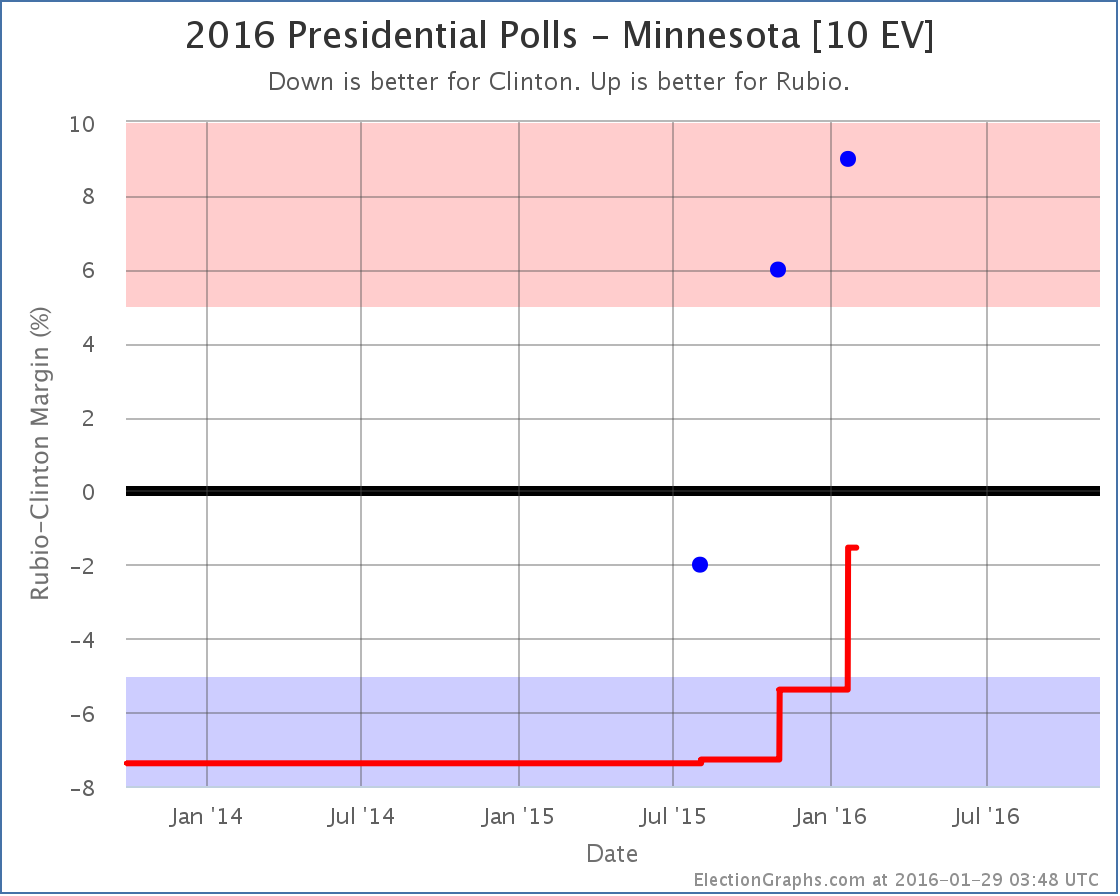
There hasn’t been a lot of polling in Minnesota, but what there is has been tilted further toward the Republicans than the five election average I use as a starting point for my poll averages. With the latest poll, the average moves to a Clinton lead of only 1.5%. This makes Minnesota start looking like a pretty close state. It makes Minnesota a possible pick up for Rubio, and therefore improves his “best case” against Clinton:
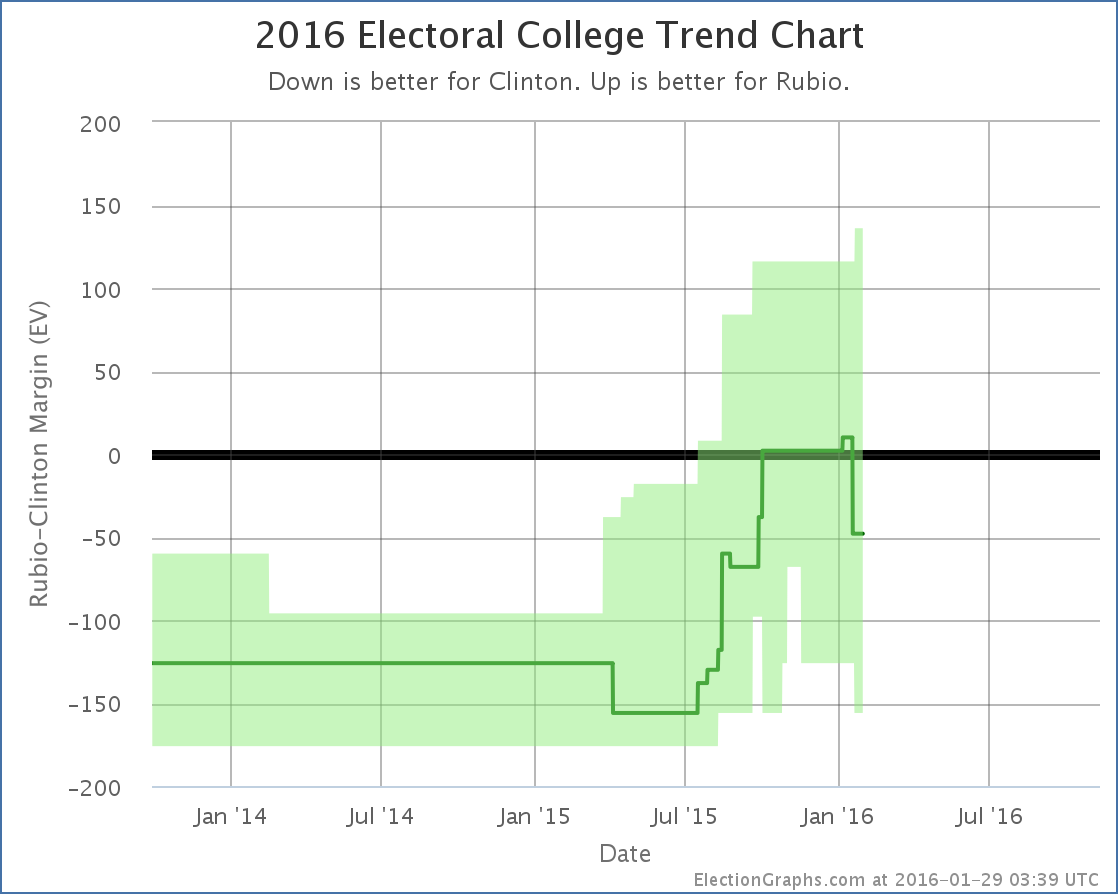
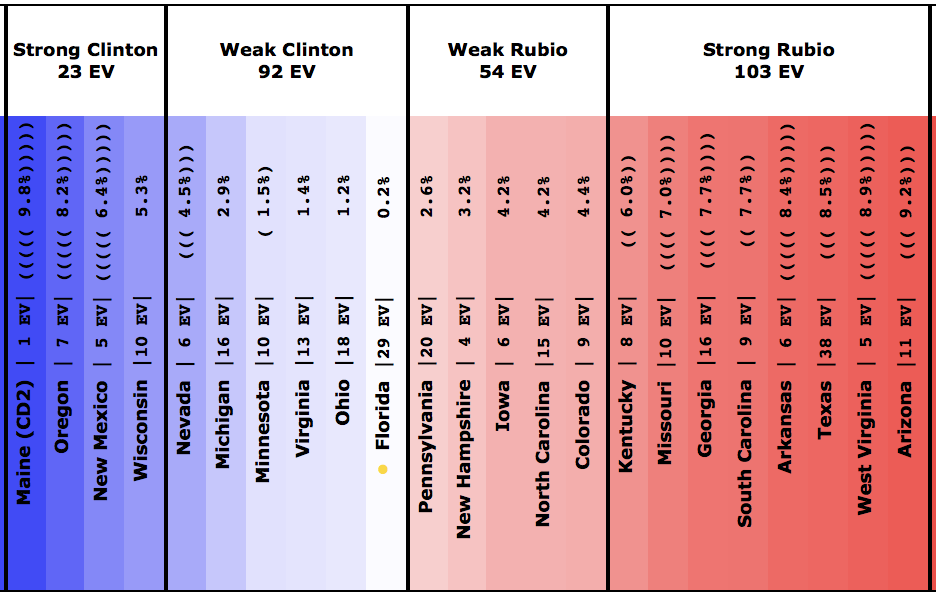
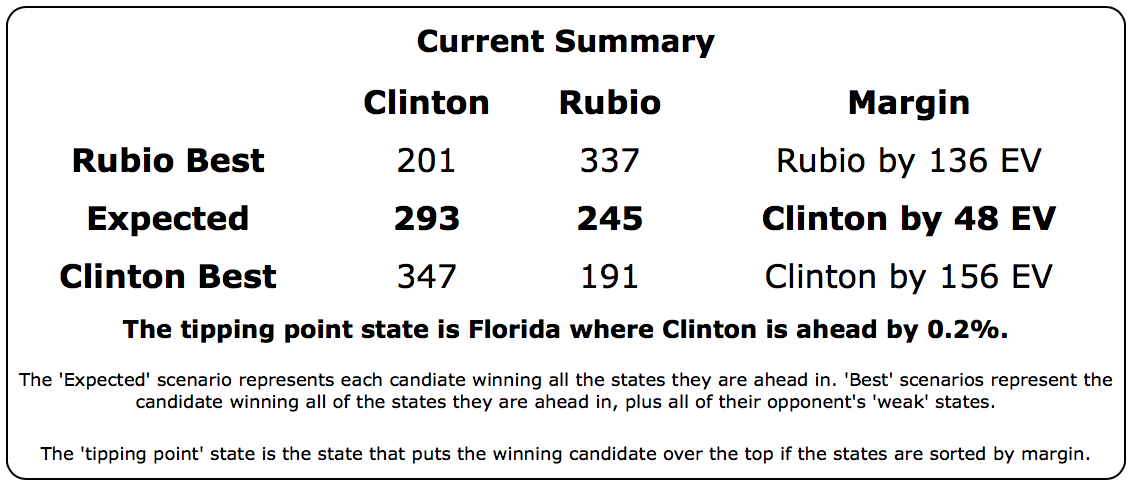
What’s remarkable looking at Clinton vs Rubio at this point is the huge number of close states. There are 146 electoral votes in the “up for grabs” category, where the polling margin is under 5% and it would be very easy to imagine the state going either way. Add to that that the tipping point is only a 0.2% Clinton lead, and Clinton vs Rubio is the most evenly matched of the five best polled candidate combinations by a decent margin. The race is very close, and the “best cases” for the two candidates are relatively close to being symmetric.
If the Republican race was about picking the candidate most likely to beat Clinton, Rubio would be way ahead. But it isn’t, and he isn’t.
Clinton vs Cruz
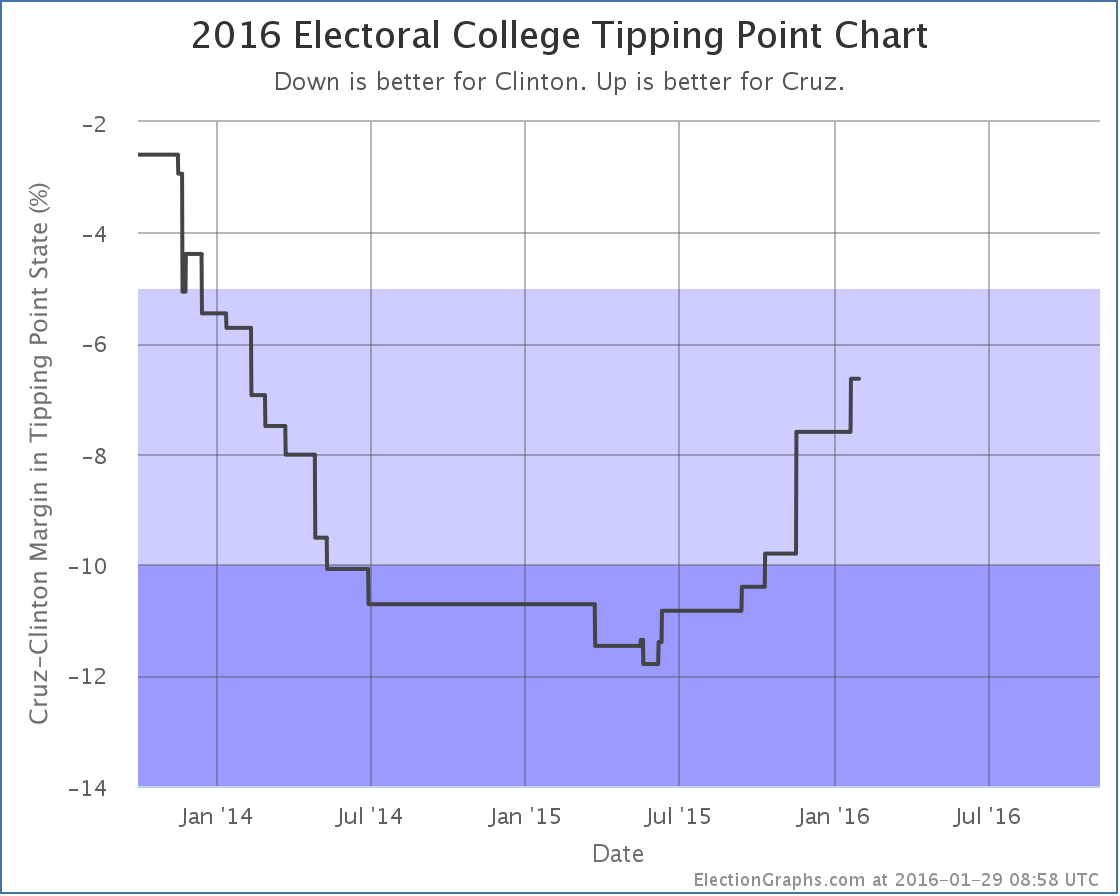
Cruz improved in Minnesota from being behind Clinton by 8.8%, to only being behind by 6.3%. This did not result in a category change, but it did move the tipping point… the state that puts the winning candidate over the edge if you put the states in order. We go from the tipping point being Virginia with a 7.6% Clinton lead, to being Florida with a 6.6% Clinton lead. This still means Cruz is very far behind. He is clearly losing to Clinton. It isn’t particularly close. But it is closer than it was. Cruz has been consistently improving on this metric since June. If Cruz stays in contention in the primaries, watch this number to see if this trend continues and Cruz starts making it an actually competitive race, or if Clinton vs Cruz continues to look like an easy Clinton win.
Clinton vs Trump
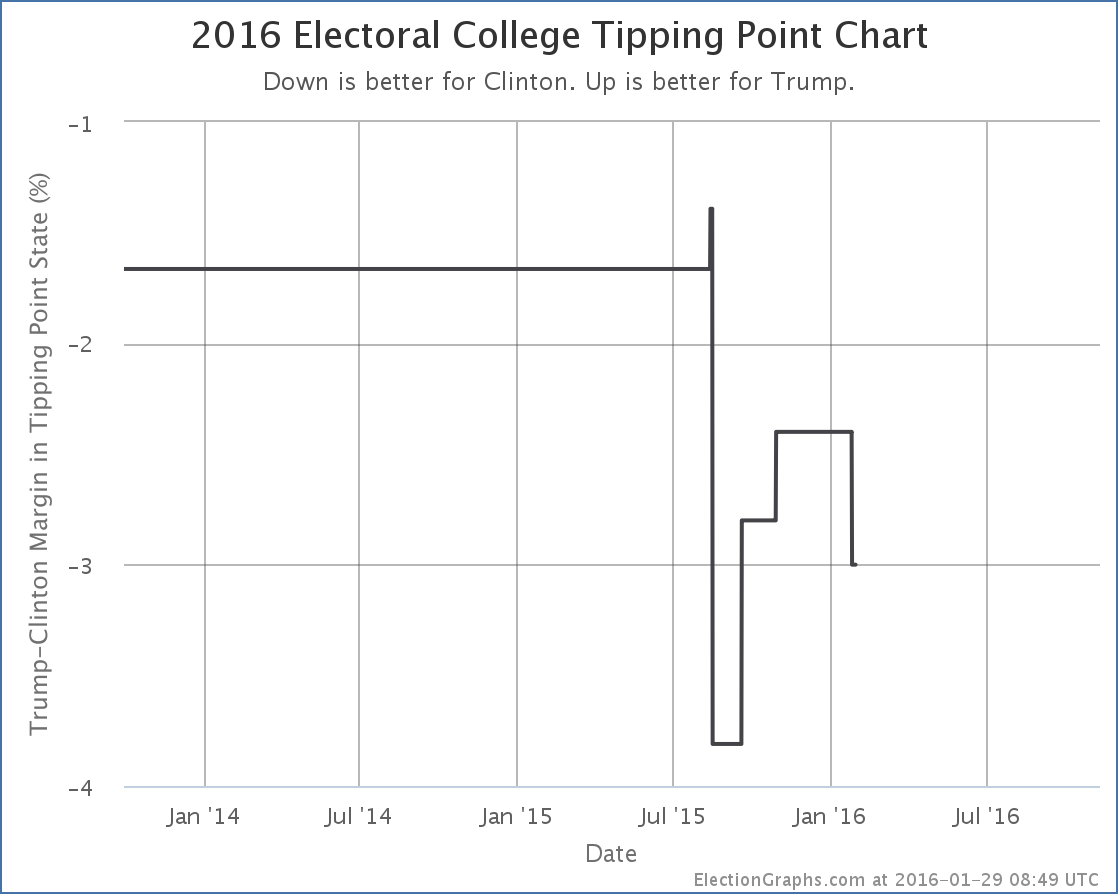
OK, technically Clinton vs Trump is #6 in terms of how well polled the candidate combination is, which means by my rules I wouldn’t be talking about it right now. But given Trump’s position in the polls, I’ll mention it anyway. New Clinton vs Trump polling in Michigan (not in Minnesota like the other two) increases Clinton’s lead from 2.4% to 3.0%. This does not move Michigan to a new category, but it does move the tipping point. In this case the tipping state was and still is Michigan, so the tipping margin just moves from 2.4% to 3.0%. There isn’t enough here to declare a real trend. And both 2.4% and 3.0% are “close”. So either way, a Clinton vs Trump race is one with a small Clinton advantage, but still a race that could go either way.
In just a few more days, we’ll have actual delegate leaders in both parties. Things are moving fast.
284.6 days until polls start to close on Election Day 2016.
Note: This post is an update based on the data on ElectionGraphs.com. Election Graphs tracks both a poll based estimate of the Electoral College and a numbers based look at the Delegate Races. All of the charts and graphs seen in this post are from that site. Additional graphs, charts and raw data can be found there. All charts above are clickable to go to the current version of the detail page the chart is from, which may contain more up to date information than the snapshots on this page, which were current as of the time of this post. Follow @ElectionGraphs on Twitter or like Election Graphs on Facebook to see announcements of updates or to join the conversation. For those interested in individual general election poll updates, follow @ElecCollPolls on Twitter for all the polls as they are added.
The Election Graphs delegate tracker is live! In the last few hours I have posted an intro to this effort, a tour of the new features, and a FAQ. But now it is time to get into the meat of things and start talking about results and what they mean.
While the Republican Party does have unbound delegates that will be able to make up their own minds independently, most of those people won’t be officially chosen until the primary/caucus season is well underway, and regardless, I haven’t yet found a good source of information tracking which of these folks is publicly supporting which Republican candidate. So the flow of delegate information for the Republicans won’t start until we get the results of the Iowa caucuses next week.
But on the Democratic side… most of the “superdelegates” are already known (although some may change before the convention). The superdelegates are Governors, Senators, Representatives, members of the Democratic National Committee, and “Distinguished Party Leaders”. As Democratic activists, these people very often are quite public about who they support. And they show up in news reports when they do that. And there are places tracking it.
Since this is the first analysis post of the primary season, I’m going to walk through the charts I use on my site, building up to the main one I believe is the one worth concentrating on going forward. If you just want to get straight to the punchline of how this race is going, skip to the last chart in the post and read from there.
Since June of 2013, slowly but surely, the superdelegates have been publicly choosing sides…
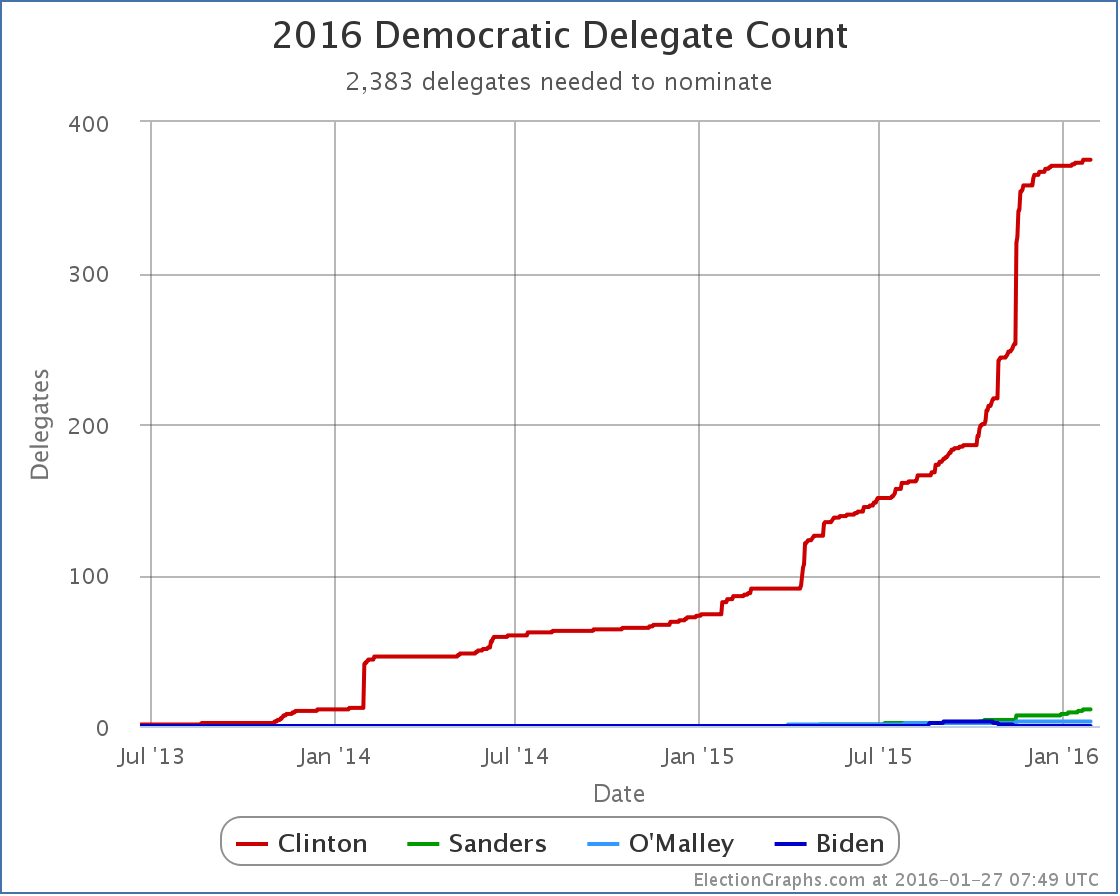
See the red line? That is Clinton. See the Green line? That is Sanders. Clinton is absolutely dominant here.
By my best count, 389 of the 713 superdelegates have expressed a preference, and 375 of those have come out for Clinton. Sanders has 11. O’Malley 3.
Now, the chart above is by date. It looks all jumpy because the delegates revealed their preferences at various random times, with a few big jumps when things happened, like Clinton officially announcing, or when AP did a survey of all the superdelegates. That can be interesting, but actually distorts the picture of how the race is coming along. Time to do a quick switch and show how this looks when we look at the % of delegates allocated instead of the date:

Suddenly, we have nearly a straight line. The lumpiness caused by the uneven distribution of delegate preference announcements over time is gone and we get a much clearer look at what is happening. We see that over 8% of the delegates to the convention have already expressed a preference. Clinton has been consistently racking these up as they come in. She is dominating in this race. But by how much? Lets switch to looking at the % of delegates each candidate has…
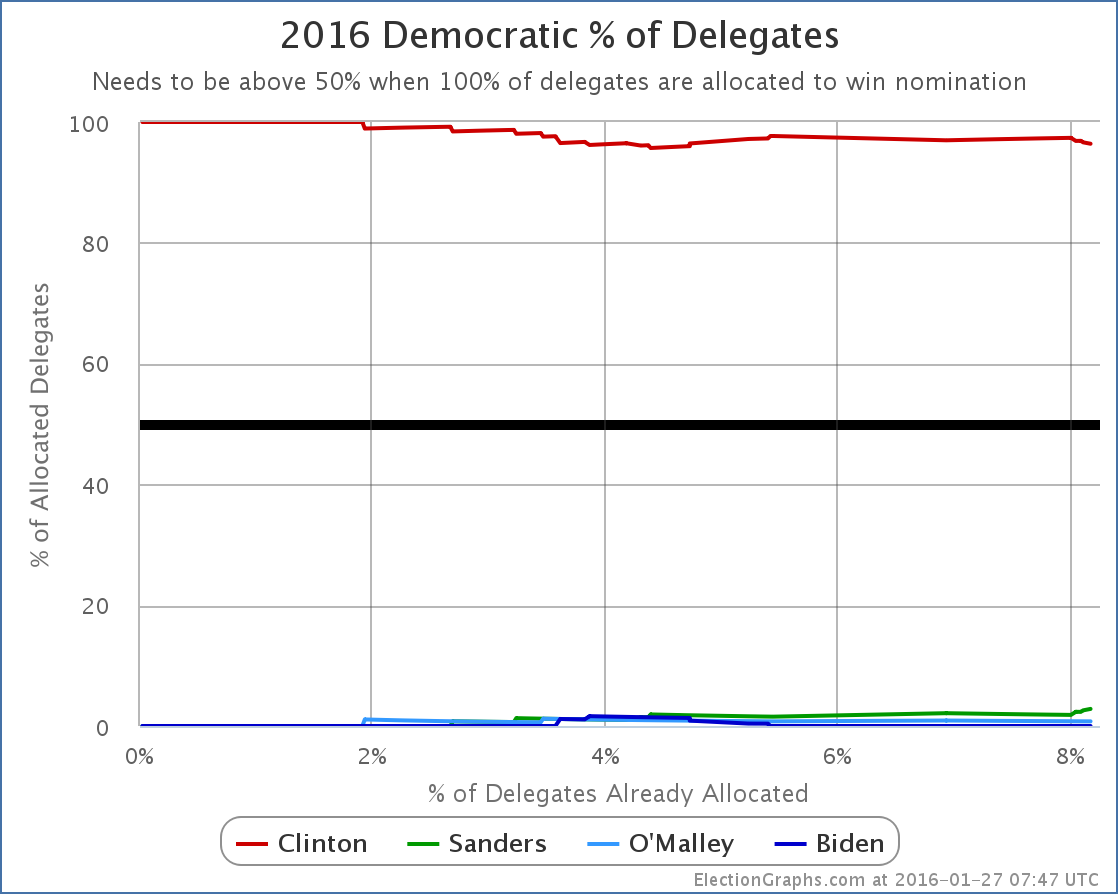
Once again we see that Clinton is dominant, but a few more details start to be seen. For instance we see that so far at least, Clinton’s weakest point was between the 4% and 5% marks when Biden, Sanders and O’Malley all had a few delegates in their columns and Clinton had about half the delegates she has today. But Biden dropped out, and Clinton kept on getting delegates at a pace not matched proportionately by Sanders or O’Malley, so Clinton’s dominant percentage increased again for awhile.
Very recently though, at the tail end of this chart, you can see that Sanders has been collecting delegates at a fast enough pace that his percentage has actually been going up, while Clinton’s has been decreasing. The Sanders percentage is still small, but it is going up. So where does that put Sanders? How about his surge? Can he win?
Time to look at the chart I consider to be the most important one to look at for understanding the race. Instead of looking at the percentage of delegates each candidate already has, we shift to looking at the percentage of the remaining delegates that the candidate would need to get in order to win the nomination:

As Clinton racks up delegates, it becomes harder and harder to catch up. With the lead she already has based on superdelegates, in order to win, Sanders doesn’t need to get 50% of the remaining delegates, he needs to get 54.22% of the remaining delegates.
Specifically looking at Iowa, 44 delegates are at stake.
To be clear, no Democratic delegates will actually be earned on the night of the Iowa caucus. It is the first step of a multi-stage process that won’t end until June. But after the precinct caucus results next week, we’ll be able to make estimates based on the initial vote results and what we know about the specific delegate allocation rules in Iowa.
With 44 delegates up for grabs, given the 54.22% number we calculated, for Sanders to actually put himself in a better position after Iowa than before, Sanders doesn’t need 22 or 23 delegates, he needs 24.
Now, if Sanders gets more delegates than Clinton, the media and press coverage about the Sanders surge and the risk to Clinton will be overwhelmingly loud. Nobody other than this site will be talking about how he won, but didn’t get to 24, so he is actually worse off. Everything will be about the Sanders win and his “momentum”.
And there is some fairness to this. If Sanders wins Iowa’s popular vote, no matter what the delegate estimates turn out to be, he will get a lot of positive attention. And people will talk about how Clinton is a lot weaker than she had seemed. That talk may improve Sanders’ position in New Hampshire or in other states further down the road. Perhaps it would boost him enough to compensate for the increase in the “% of remaining needed to win” that would result from falling short of 54.22% in Iowa. Getting a narrow win that doesn’t get enough delegates to actually improve the overall position in the short term may actually still have a positive impact in the medium to long run. Spin matters.
The polls are close in Iowa, either Clinton or Sanders could easily take the state. But the numbers to watch are not the popular vote totals. You shouldn’t even be looking simply at who is estimated to get the most delegates. The question is if the person who gets the most delegates gets enough to be on pace to win.
For someone other than Clinton to win, they have to start by catching up. This already means that they have to get more than 54% of delegates as we go forward. If they fail to reach that number, with each subsequent contest they will have to do even better to catch up.
If they do reach that bar though, each subsequent contest becomes easier. That’s the way it works. But the target is not getting the most delegates in each contest. It is getting more than the number you need to be on pace to win. Right now Sanders needs 54.22% of the delegates. Clinton only needs 45.90% of the delegates. She doesn’t even need to get a majority since she has already banked so many delegates before voting even starts.
So far, in the “invisible primary”, Clinton has scored an incredible 96.4% of the delegates. This will not continue. The Democratic leaders that make up the superdelegates have a very different perspective and background than Iowa caucus goers, or New Hampshire primary voters. Sanders will do better than the 2.8% of delegates he has managed so far. The question is how much better and if it puts him on track to actually catch up and win, or if it quickly becomes apparent that he is just playing the role of the protest candidate almost everyone originally expected him to be.
If Sanders doesn’t get to that 54.22% mark in Iowa, we may know pretty quickly that he is falling short, although if he wins in the popular vote, there will still be a crazy media circus for weeks.
If he exceeds that mark though, then the media howling might actually be warranted. At least until South Carolina. South Carolina is a very different state than either Iowa and New Hampshire, and the picture might change dramatically again after that.
But the next few weeks will be exciting almost any way the results go. And we haven’t even talked about the Republicans this time since there aren’t any delegates to look at quite yet. There will certainly be quite a bit of excitement on that side as well.
Tune in here for all the twists and turns as this race shifts into high gear!
Just under a week until Iowa. Hold on tight.
Note: This post is an update based on the data on ElectionGraphs.com. Election Graphs tracks both a poll based estimate of the Electoral College and a numbers based look at the Delegate Races. All of the charts and graphs seen in this post are from that site. Additional graphs, charts and raw data can be found there. All charts above are clickable to go to the current version of the detail page the chart is from, which may contain more up to date information than the snapshots on this page, which were current as of the time of this post. Follow @ElectionGraphs on Twitter or like Election Graphs on Facebook to see announcements of updates or to join the conversation. For those interested in individual general election poll updates, follow @ElecCollPolls on Twitter for all the polls as they are added.
[Edit 06:45 UTC to fix wording]
[Edit 08:09 UTC to update graphs]
[Edit 08:15 UTC to fix typo]
[Edit 2016-02-02 06:03 UTC to change “Delegate Race” in title to “Democrats” in preparation for separating posts on the two races]
On Curmudgeon’s Corner this week, Sam and Ivan talk about, what else, the presidential race. On the Republican side: What is up with Sarah Palin? Does Trump really represent conservatism? That Cruz eligibility thing. And more. On the Democratic side: Does Sanders have a chance? Will Clinton’s negativity backfire? The Idealism vs Pragmatism conflict. And more. Then a sharp turn away from politics and for some reason they talk about Star Wars for 15 minutes. Shrug. Oh yeah, and WiFi sucks.
Click below to listen or subscribe… then let us know your own thoughts!

Recorded 2016-01-22
Length this week – 1:25:39
 1-Click Subscribe in iTunes 1-Click Subscribe in iTunes
 View Podcast in iTunes View Podcast in iTunes
 View Raw Podcast Feed View Raw Podcast Feed
 Download MP3 File Download MP3 File
 Follow the podcast on Facebook Follow the podcast on Facebook
Show Details:
- (0:00:10-0:03:41) Intro
- Agenda
- Listener Request
- Boring Lives
- (0:04:21-0:42:31) Election 2016 – Republicans
- Sarah Palin
- WiFi Sucks
- Sarah Palin again
- Trumpism and Palinism vs Conservatism
- Establishment coming around to Trump?
- Dynamics approaching Iowa
- Will anybody stop Trump?
- Cruz eligibility
- Trump foreign policy
- (0:43:34-1:07:13) Election 2016 – Democrats
- Clinton will win…
- …unless she screws it up
- Negativity backlash?
- Base vs Centrist divide
- Embracing Obama
- Iowa and New Hampshire
- Hillary in trouble freakout
- How might Clinton blow it?
- Sanders vs Trump?
- National Review’s anti-Trump issue
- (1:08:23-1:25:19) Star Wars Lightning Round
- Movie: Star Wars – The Force Awakens (2015)
- Lucas Sour Grapes
- What was wrong with the prequels?
- Where is Rey?
- Kylo Ren
- Feedback
My primary race delegate tracking for both parties will be out very soon… promise. In the mean time, rather than just looking at the delegate leaders on each side against each other, we continue to concentrate on the five best polled candidate combinations.
With a batch of new polls added in North Carolina, Florida, and New Hampshire, it starts to look like the long trend of Clinton getting weaker and weaker against a wide variety of Republican rivals may have ended. Maybe. For now. A little bit. Things will change before we are done. Polls like these aren’t predictive of the general election until after the conventions. Caveat caveat caveat.
Lets look at each category change by state:
Florida (29 EV)
Of the best five polled candidate combinations, two Republicans have their positions deteriorate against Clinton in this update, Bush and Rubio:
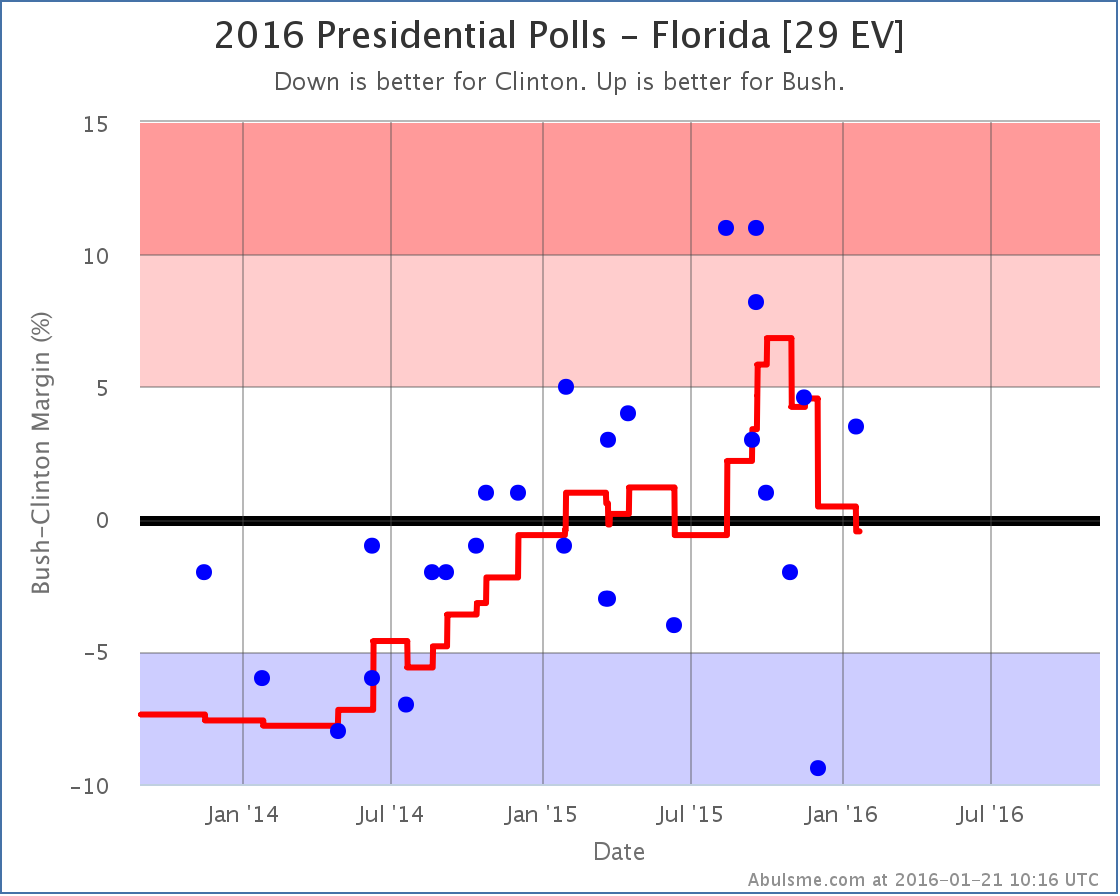
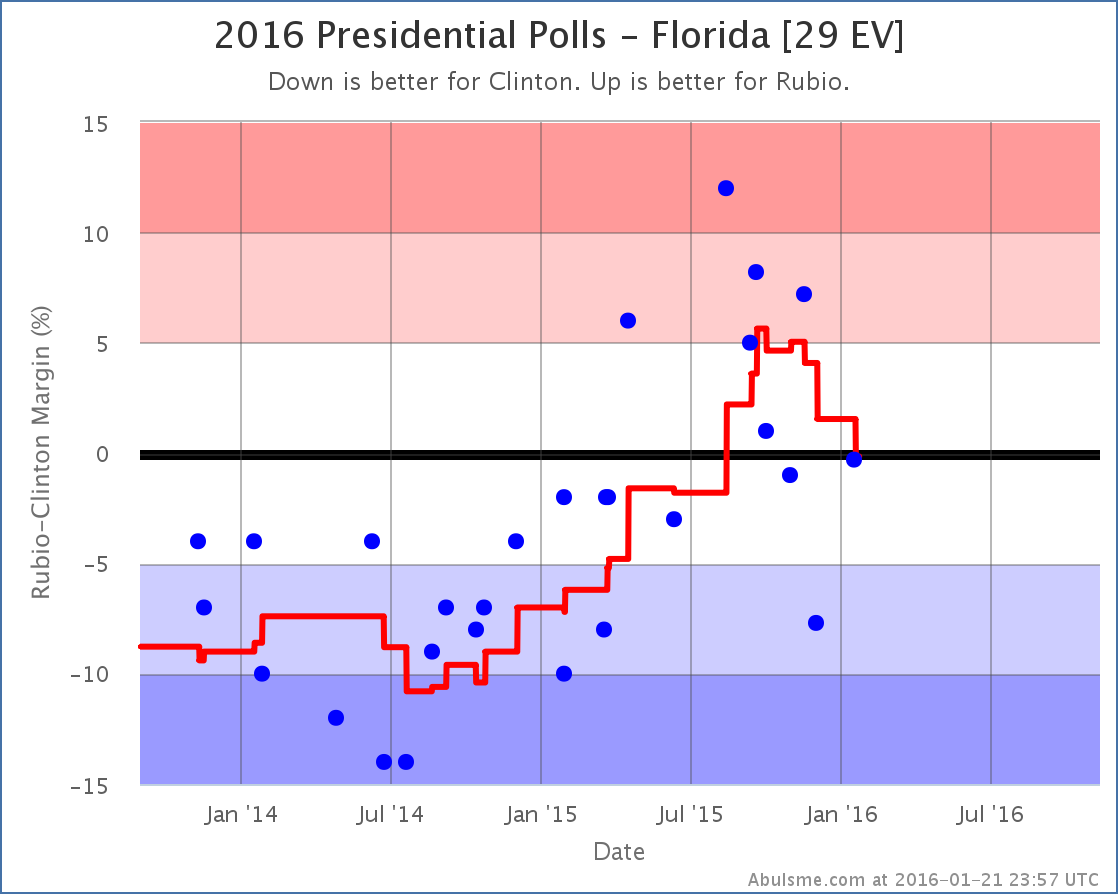
Both candidates seemed to peak in late September or early October, and since then have been weakening. With the latest set of poll updates, both states move from being weakly on the Republican side of the line, to being Weak Clinton. The “weak” here should be emphasized. Clinton’s lead over Bush in the average is only 0.5%, and over Rubio it is only 0.2%. This is about as close as you can get. Since for the analysis here any lead under 5% is considered as one that could easily disappear overnight, at these even smaller margins, this is essentially a tie. But for the last few months, the movement has been in Clinton’s direction.
North Carolina (15 EV)
In North Carolina, once again Bush and Rubio lose ground to Clinton. Although technically with the current update Clinton vs Trump dropped to the 6th best polled candidate combination, I know the Trumpets will want to hear about how he is doing, so I’ll mention that Trump also weakens in North Carolina. Yes, yes, I know that any such indications are just propaganda from the vast establishment conspiracy of which I am a part. But anyway… looking at the charts:
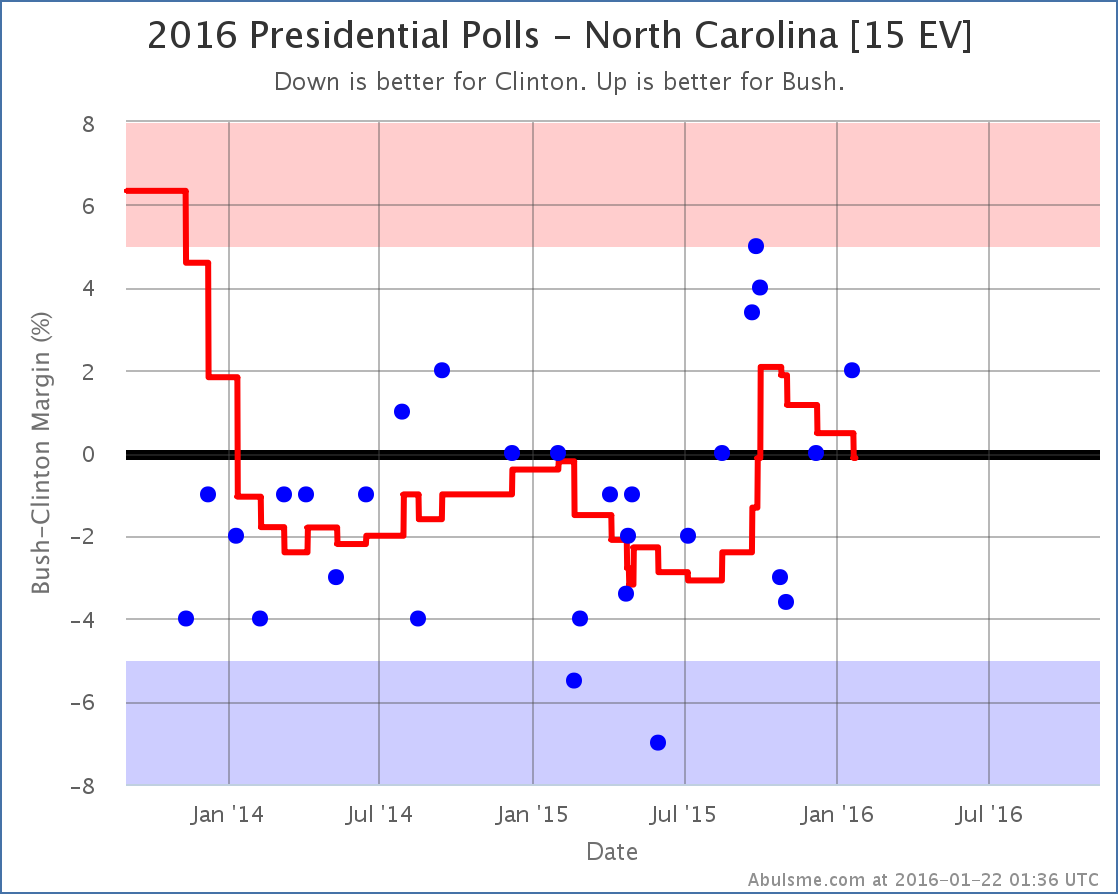
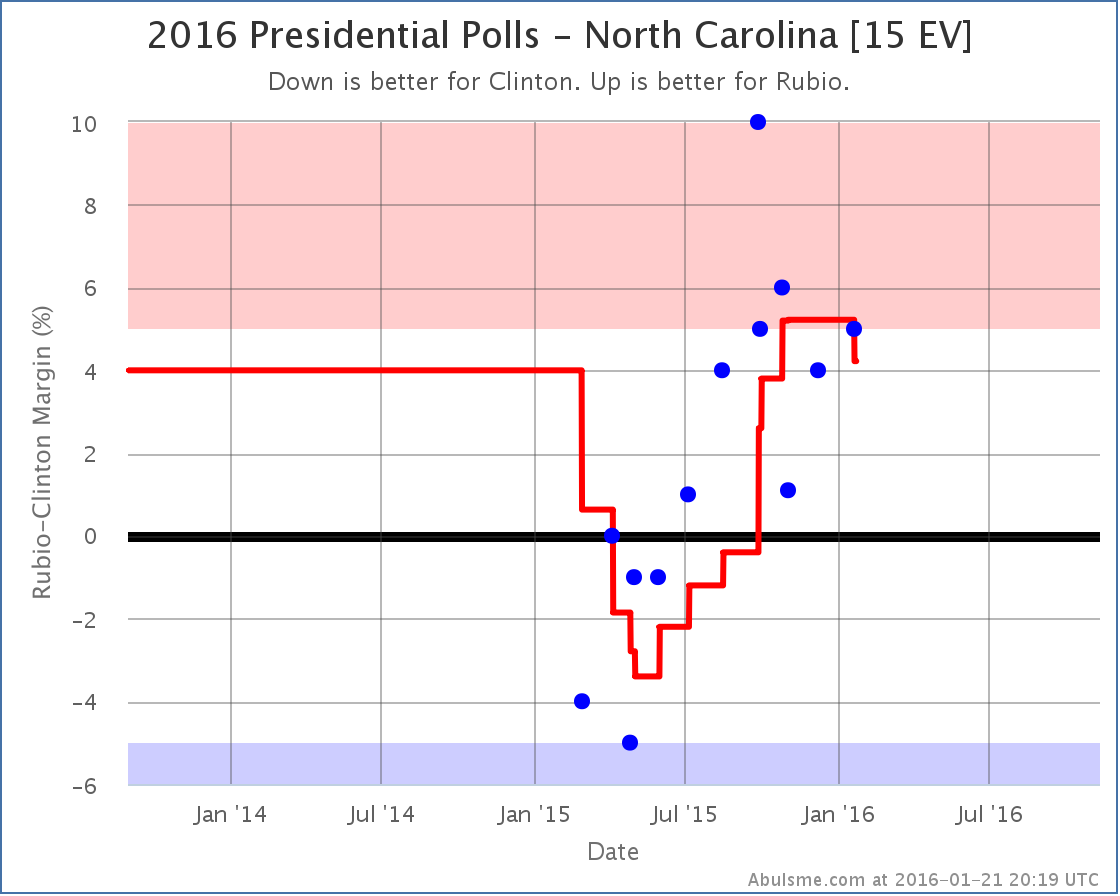
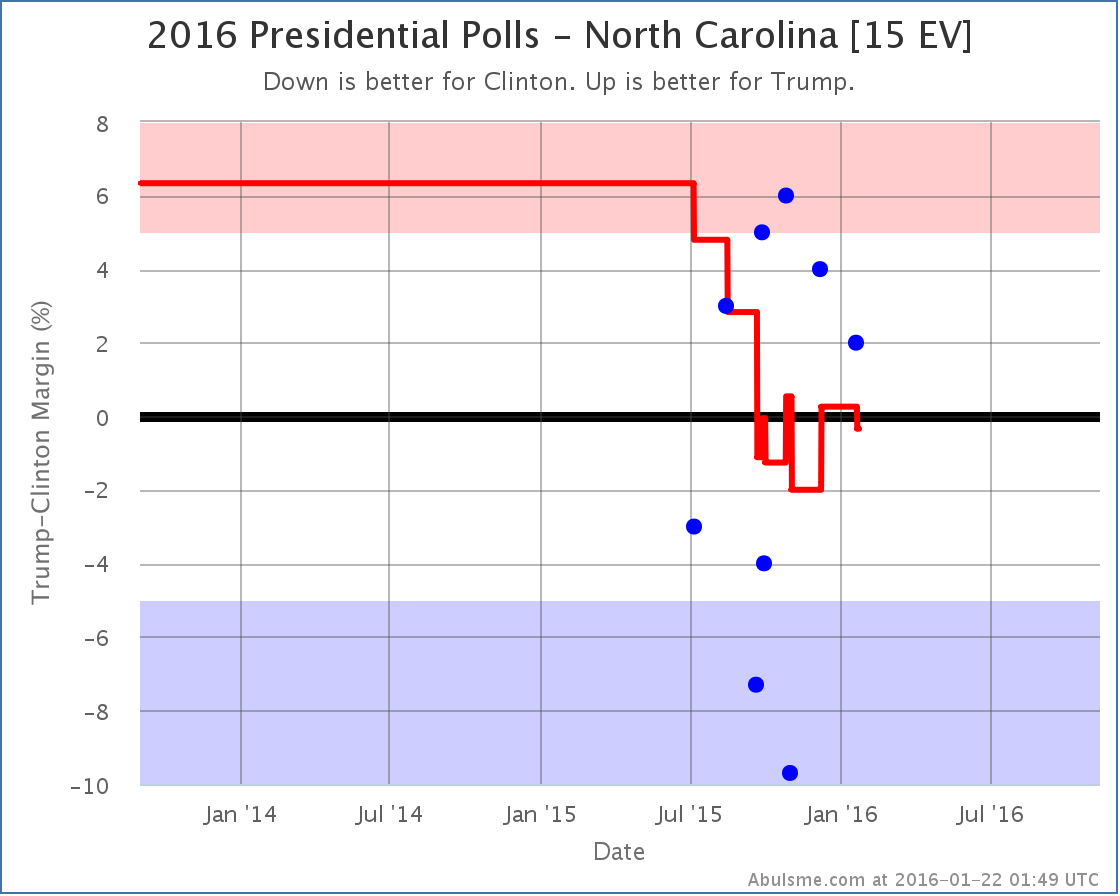
In this case the averages for Bush and Trump against Clinton move from Weak Republican to Weak Clinton, but once again the “weak” is the key here. Clinton leads Bush by 0.1% and Trump by 0.3%. So again, super close. A move from just barely on one side of the line to just barely on the other side of the line isn’t really too meaningful except if it seems part of a larger movement. In the case of Bush, the average seems to have been moving toward Clinton for several months. In the case of Trump, it is more bouncing around in a range over the past few months.
Rubio does a bit better here. North Carolina had actually been in the “Strong Rubio” category for a few months, with the poll average showing a Rubio lead of over 5%. With the latest update, Rubio’s lead slips under 5% to 4.2%, which means I once again consider North Carolina a state that could go either way in this matchup, but Rubio still has a lead.
New Hampshire [4 EV]
New Hampshire is the one state that has good news for the Republicans in this update. No category changes for Bush, Rubio, or Trump… but this time Cruz jumps into a new category.
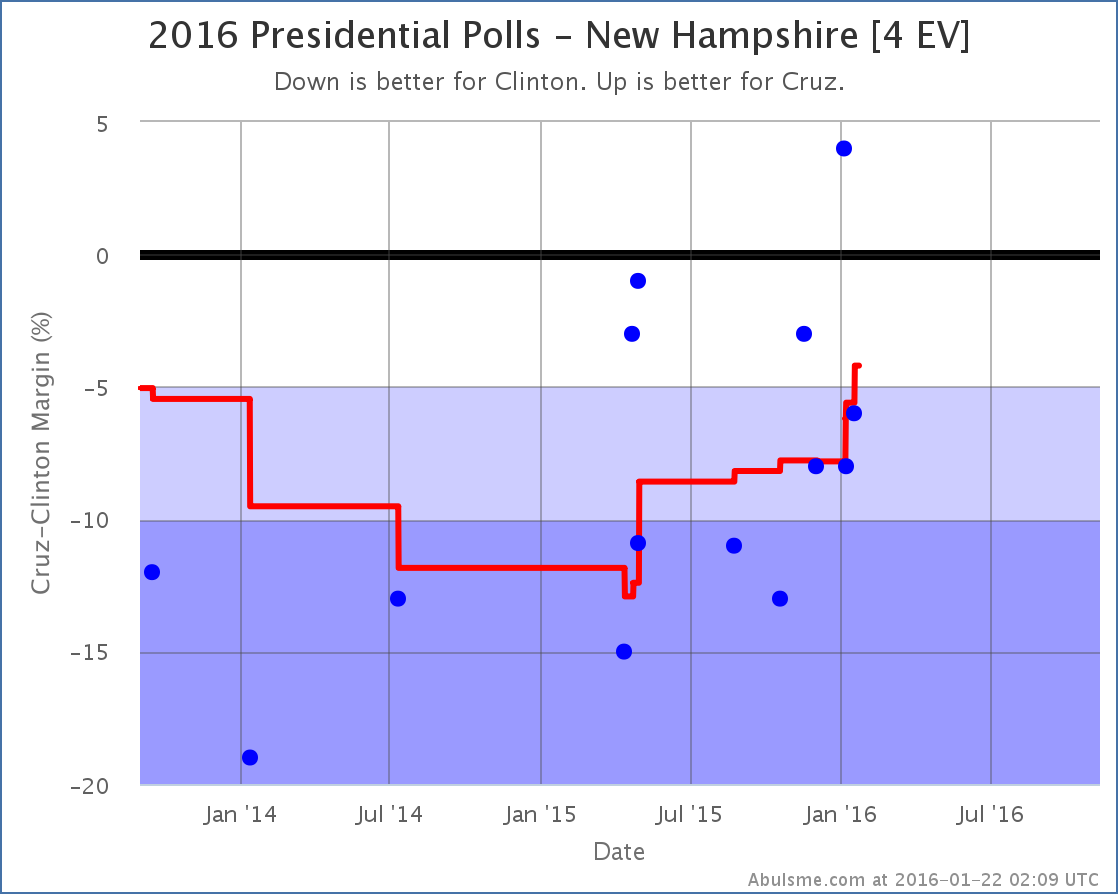
Cruz’s recent movement in New Hampshire is the opposite of the trends we were looking at for the other candidates in the other states. Cruz is gaining on Clinton in New Hampshire. For the first time, the state starts to look competitive in this match up. Clinton is still up 4.2% in the average, but now it is conceivably within reach for Cruz.
National Ranges
So with all these various changes, what do things look like nationally for all these candidate pairs? Here we go:
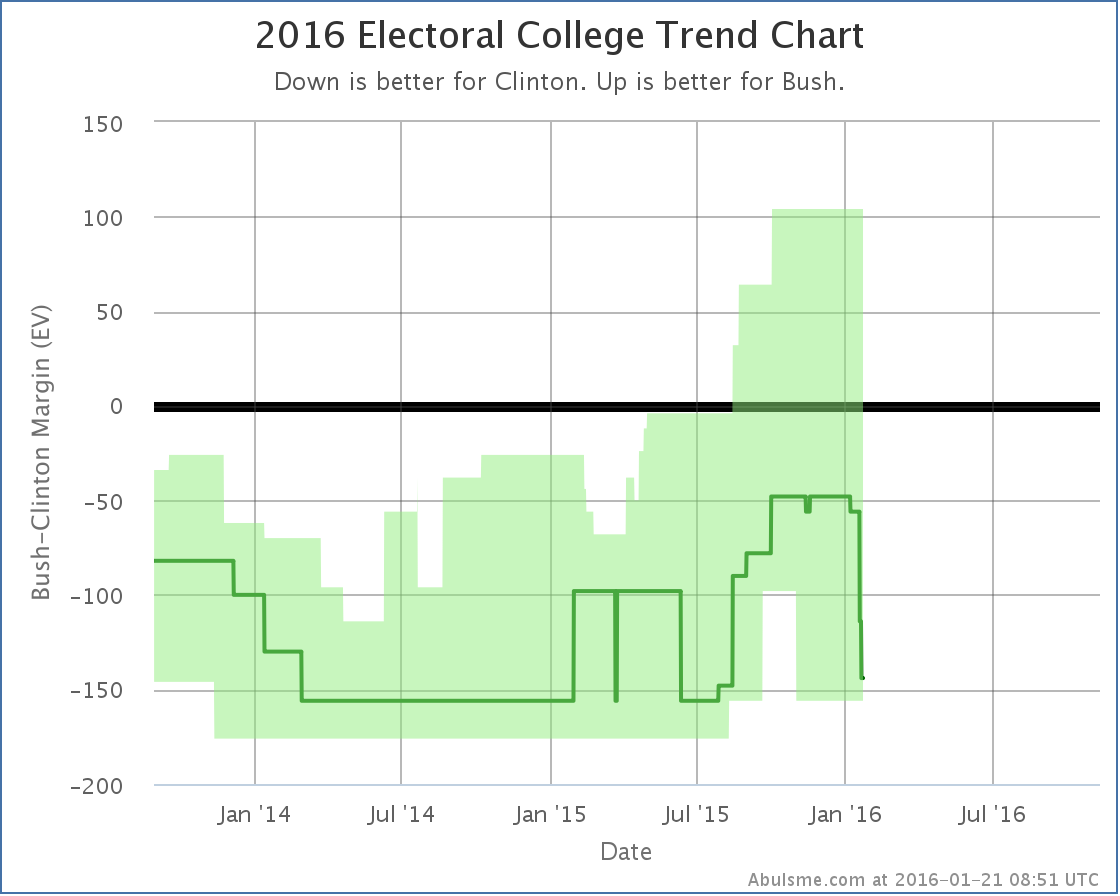
With Florida and North Carolina back out of his column, the result if everybody just wins the states they are ahead in now sits at Bush losing by 144 electoral votes. If he manages to flip the states where Clinton is ahead by less than 5% he could still win by up to 104 electoral votes though, so while Bush is behind, this is still a race.
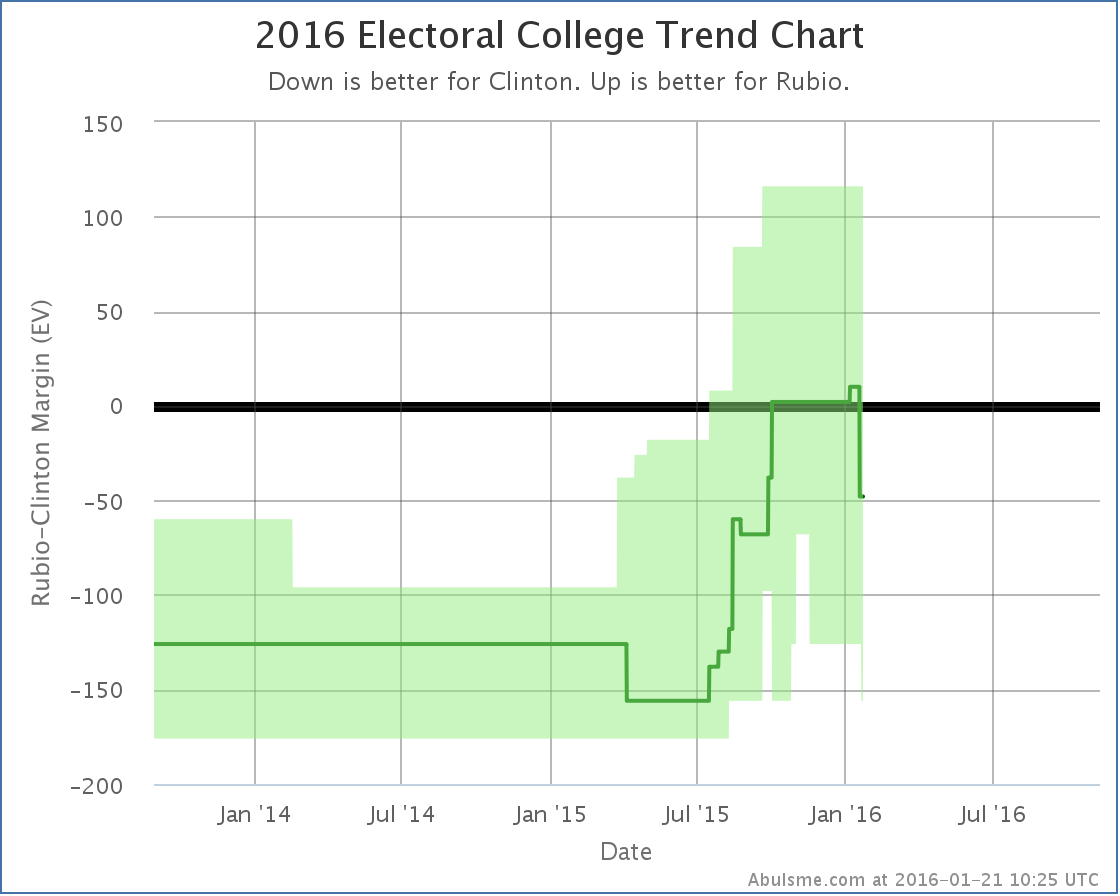
Before this update, Clinton vs Rubio was actually expected to be a narrow 10 electoral vote Rubio win. But if you take Florida away, that changes into a 48 electoral vote loss. With North Carolina also now considered a possibility for Clinton, Clinton’s “best case” improves to a 156 electoral vote win. Rubio’s best case is still a 116 electoral vote win though, so this matchup is also a real race that could go either way.
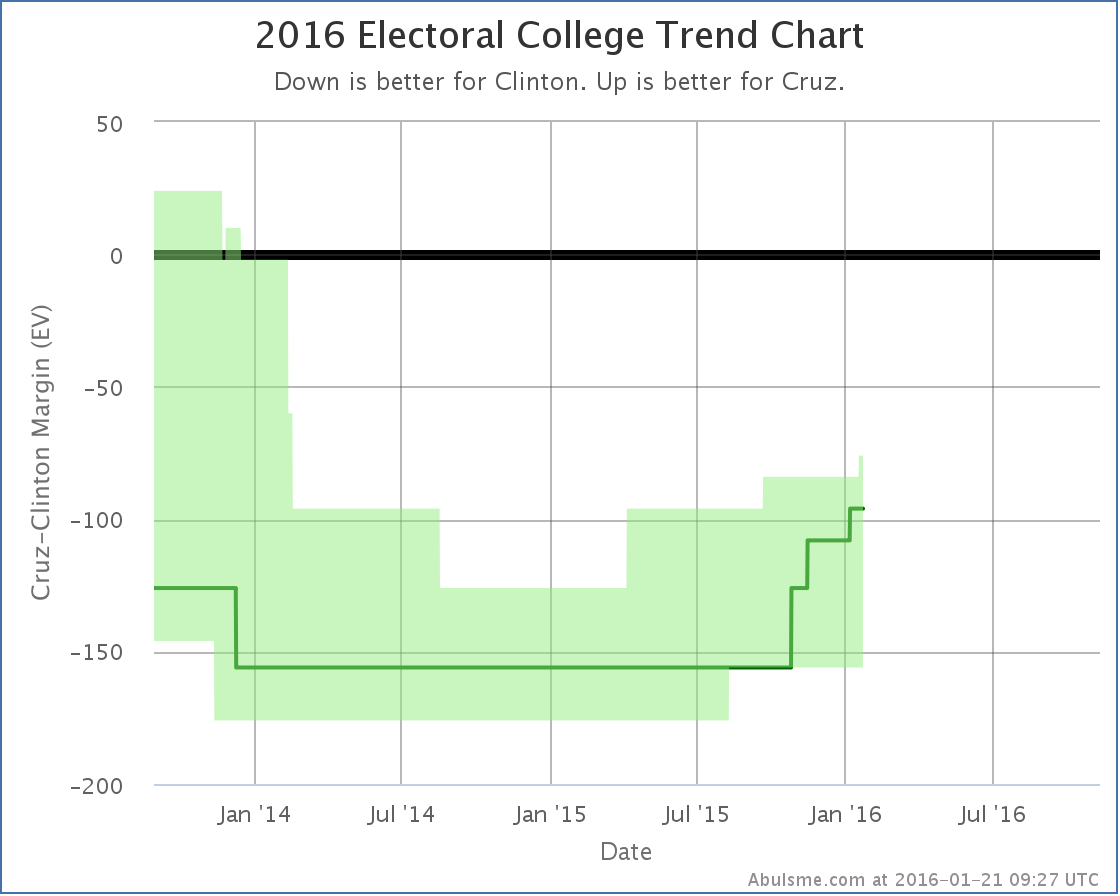
On the other hand… making New Hampshire possible brings Cruz’s best case… where he wins every state he is ahead in, plus all the states where Clinton’s lead is less than 5%… to Cruz losing by 76 electoral votes. This is better than it was. Cruz has been improving since last spring. But he is still not yet in a place that would make a Clinton vs Cruz race even competitive. Right now that matchup looks like an easy Clinton win.
Now, the Real Clear Politics average for Clinton vs Cruz actually shows Cruz ahead of Clinton right now. (Rubio too.) How does this mesh? First thing to note is that the state level polling that the estimates on this site are based on are still not happening quickly enough to show national movement that happens on timeframes less than a few months. So it is quite possible there has been a recent move just isn’t reflected in the state numbers yet. If so, if Cruz ends up the nominee, there will be a lot more polling, and we’ll see the state level analysis move toward the national numbers as more data becomes available. It is of course also possible that Cruz’s support is distributed between states in such a way that gives him a popular vote advantage while still leaving him behind in the electoral college. To be frank though, that is less likely.
Given that, it is reasonable to think that perhaps the gains Cruz showed in the New Hampshire update today are quite likely happening in other states as well, there just isn’t the polling available yet to show it on a state by state basis. So Cruz may be stronger than he appears on this chart.
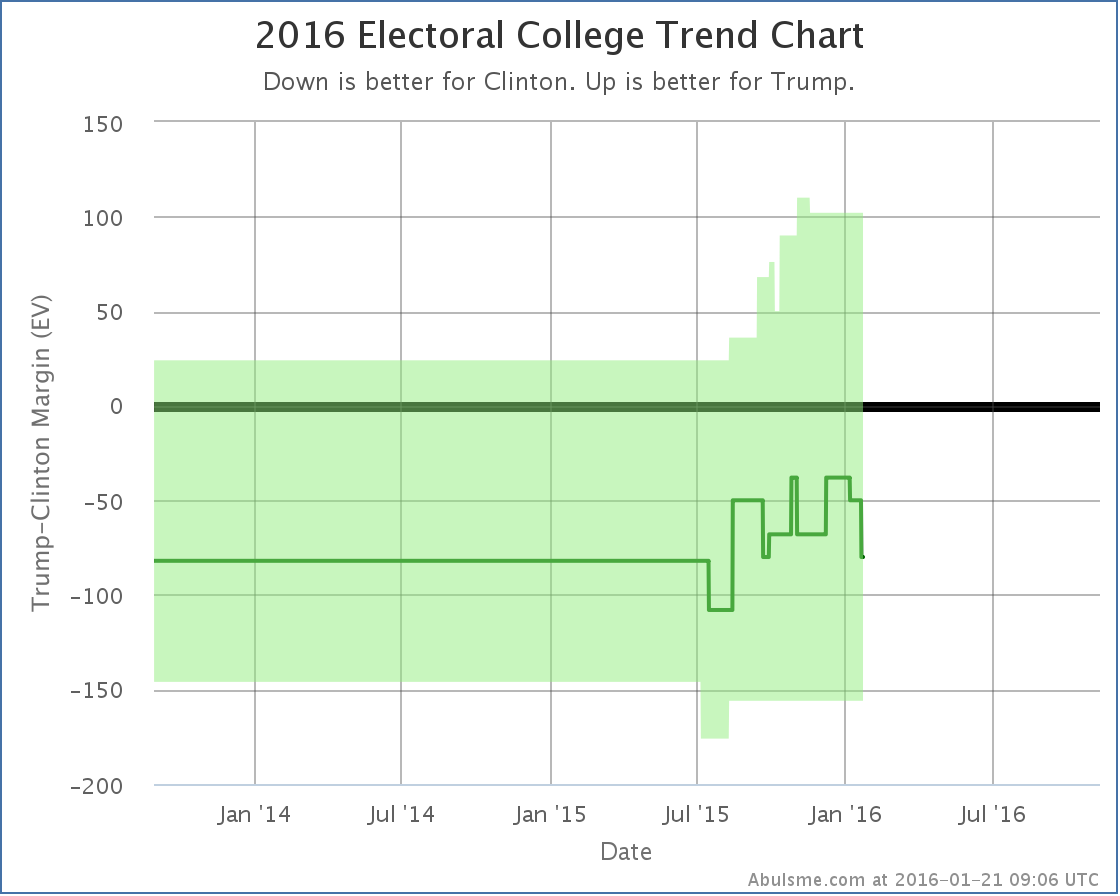
There really wasn’t polling on Trump before this summer, so most if not all of the movement seen here is not real movement, but just the process of getting enough polls to have a reasonable picture of how Trump is doing. The “expected” case doesn’t show a real trend, it has just bounced around a bit. Trump’s best case kept improving as more polls became available. At the moment, the state poll averages show a Clinton vs Trump race could reasonably be anywhere from a 156 electoral vote Clinton win to a 102 electoral vote Trump win, with the “expected case” being an 80 electoral vote win by Clinton. But this matchup DOES look like a real race, not a Clinton rout. Trump does better against Clinton than either Cruz or Bush. Of these four, only Rubio does better.
Or course, I should repeat all the usual caveats again. See the top of this post. There is still lots of time. Everything can and will change over the next few months.
291.9 days until the polls start to close. 11 days until the Iowa caucuses.
This whole thing is going to start moving very quickly very soon.
PS for Sanders fans: Although no match up vs Sanders has been polled enough to talk about in detail here, with today’s updates Sanders strengthened vs Rubio in North Carolina, while weakening against both Rubio and Cruz in Florida.
Note: This post is an update based on the data on ElectionGraphs.com. All of the charts and graphs seen here are from that site. Graphs, charts and raw data can be found there for the race nationally and in each state for every candidate combination that has been polled at the state level. In addition, comparisons of the best polled candidate combinations both nationally and each in each state are available. All charts above are clickable to go to the current version of the detail page the chart is from, which may contain more up to date information than the snapshots on this page, which were current as of the time of this post. Follow @ElecCollPolls on Twitter for specific poll details as I add them. And like Election Graphs on Facebook!
On this week’s Curmudgeon’s Corner, Sam and Ivan catch up with the developments of the last few weeks for the Presidential race. They cover all the dynamics on the Republican side, and discuss if Sanders really is a threat to Clinton on the Democratic side. In the lightning round, a round up of some other recent news… Chinese markets, Iran and Saudi Arabia, CES, Y’all Qaeda in Oregon, book and TV show reviews, and more!
Click below to listen or subscribe… then let us know your own thoughts!

Recorded 2016-01-14
Length this week – 1:36:59
 1-Click Subscribe in iTunes 1-Click Subscribe in iTunes
 View Podcast in iTunes View Podcast in iTunes
 View Raw Podcast Feed View Raw Podcast Feed
 Download MP3 File Download MP3 File
 Follow the podcast on Facebook Follow the podcast on Facebook
Show Details:
- (0:00:10-0:14:19) Intro
- (0:15:07-0:42:25) Election 2016 – Republicans
- Internet Slowdowns
- Iowa Polls
- Trump’s Cruz Birtherism
- Likely Voter Models
- Rapid Poll Movements
- Kasich surge?
- Debates
- Candidates Dropping Out
- Contested Convention scenarios
- State by State Delegate Rules
- (0:43:02-0:59:45) Election 2016 – Democrats
- More on Republican delegate allocation in Iowa and New Hampshire
- Clinton lead slipping
- Why the late Sanders surge?
- What if Clinton loses both Iowa and New Hampshire?
- Clinton superdelegate advantage
- Media bias toward a close race
- Possible Clinton meltdowns
- Trump’s position vs Clinton’s position
- (1:00:48-1:36:39) Lightning Round
- Book: Conversations with Myself
- TV Series: Star Trek (TOS) [1966-1969]
- If you disagree, you just aren’t listening
- Iran / Saudi Arabia
- Iran and the Navy boats
- CES
- Y’all Qaeda
- Secretary Carter’s Email
- Twitter Character Limit
- Other things we missed
Another day with more Iowa and New Hampshire polls. This time no status changes in the five best polled candidate combinations in New Hampshire, but there were a couple of changes to talk about in Iowa. One of these favors Clinton, the other favors her Republican opponent. Lets take a look.
Clinton vs Trump
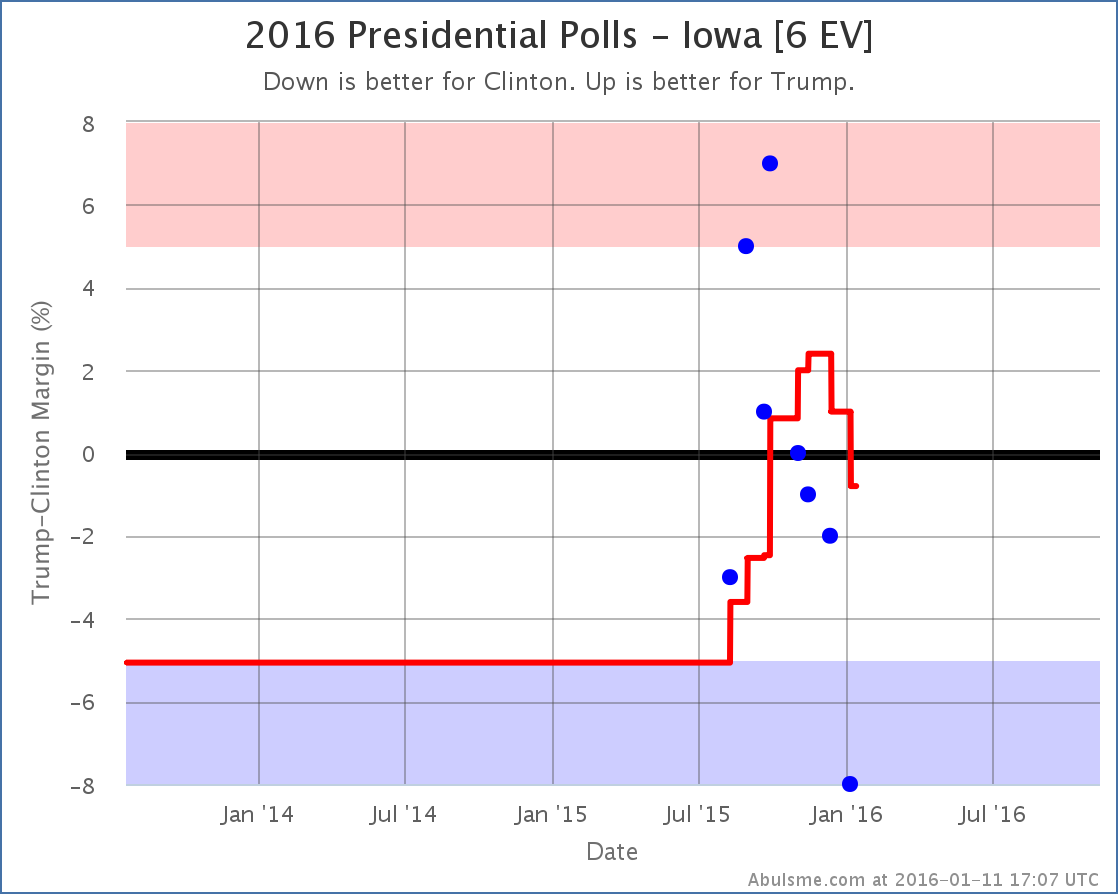
At the end of September after a series of good polls vs Clinton in Iowa, Trump had taken the lead in the Iowa poll average. Since then Trump hasn’t done quite as well, and with today’s addition of a Marist poll showing Clinton with up by 8%, the poll average once again shows a Clinton lead in Iowa.
Clinton’s is only ahead by 0.8%, which means Iowa is still close and could easily go either way. The five polls included in the average range from Clinton up by 8% to Trump up by 7%. That is a pretty big range!
The average puts Iowa in the “Weak Clinton” category though, so we give it to Clinton in the “expected case” for the moment. The updated national electoral college bubble looks like this:
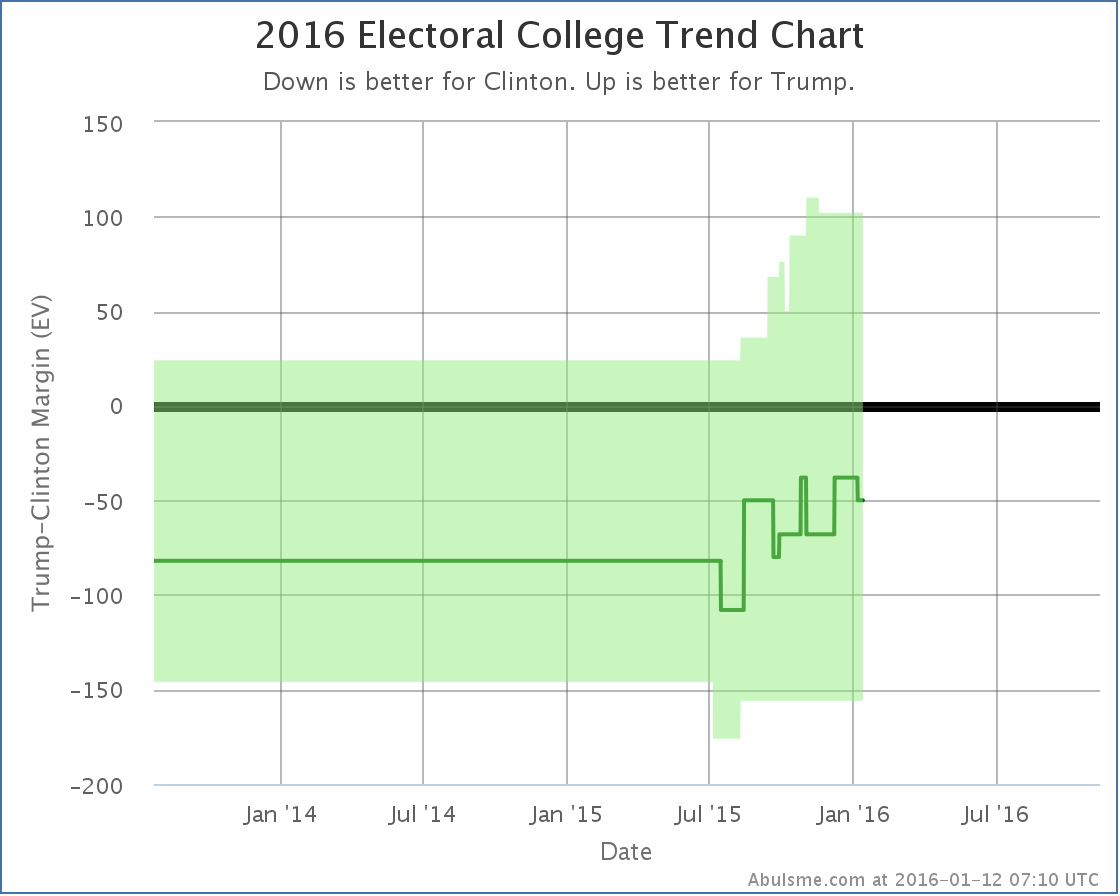
The last tick downward in the green center line is Iowa flipping to Clinton, which puts the “expected” Clinton vs Trump case at a 50 electoral vote Clinton win. But there are many close states still, so anything from a 156 electoral vote Clinton win to a 102 electoral vote Trump win would be within the realm of possibility given current state level polling.
This just goes to reiterate the point I made last month: “Do Not Underestimate Trump“. Conventional wisdom is that if the election comes down to Clinton vs Trump, it would be a Clinton runaway win, but poll data just does not show that right now.
(Insert usual comments here about how far we have until the election and how none of this is predictive yet. It only shows us a bit about how things look NOW, and even then only imperfectly due to the relative sparseness of state level polling.)
Clinton vs Cruz
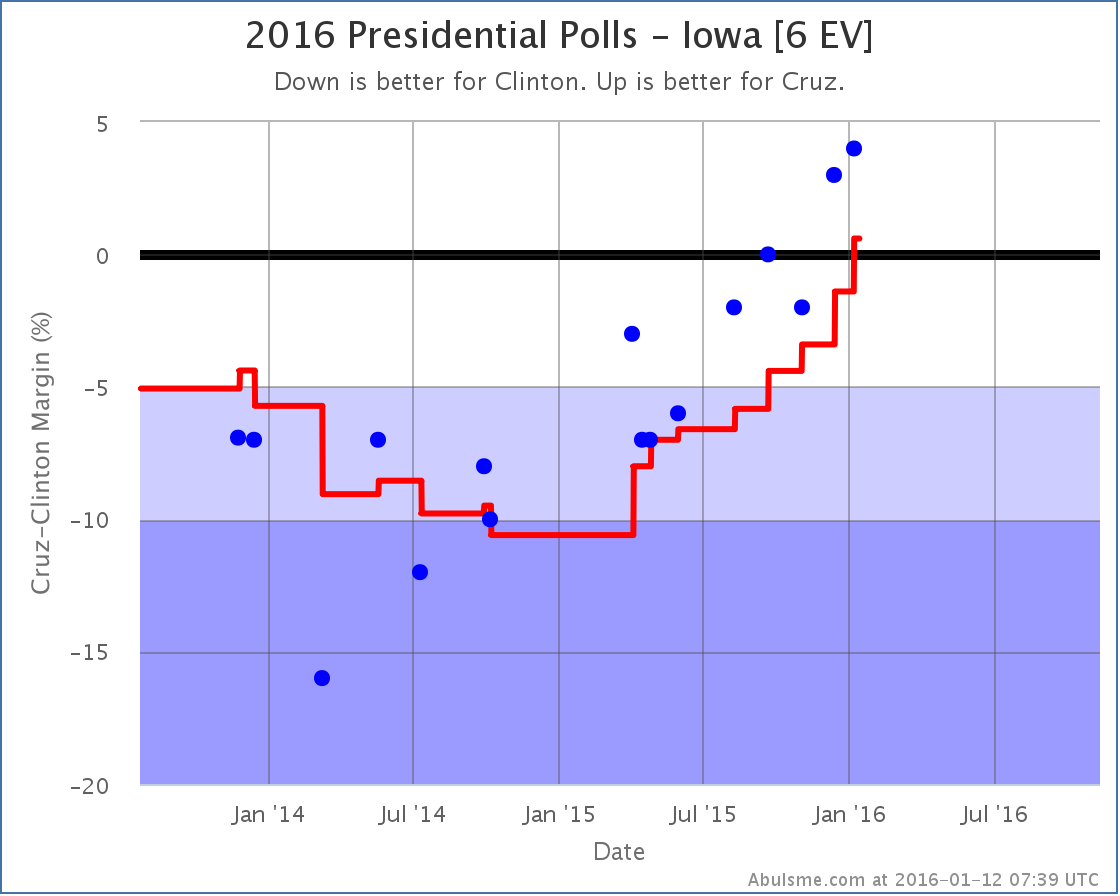
Unlike Trump, who rose for awhile and then has been falling, Cruz has been consistently improving in Iowa for the last year. With today’s update, he takes the lead in the poll average. It is just a 0.6% lead, but it is a lead, and we give him the state for now.
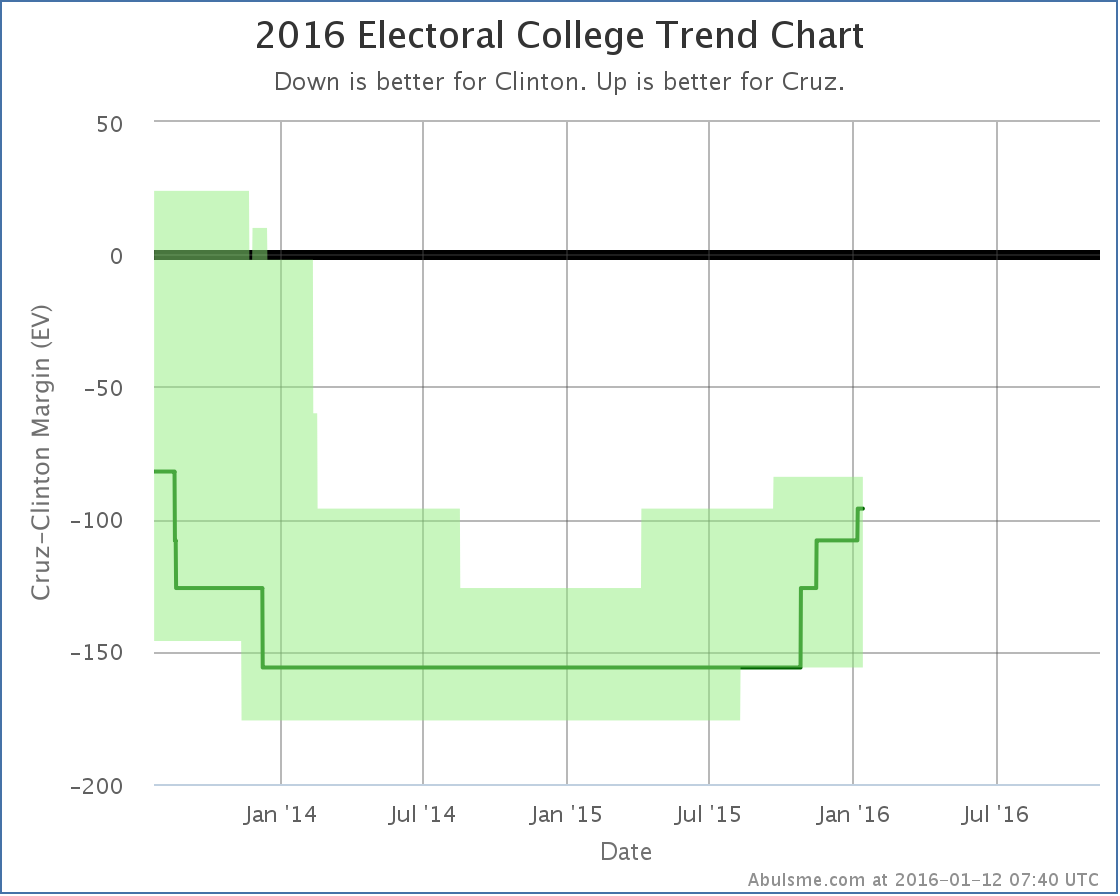
This brings Cruz up to… losing by 96 electoral votes to Clinton. Unlike Trump though, if you give him all the close states as well, it is still a loss to Clinton, just by only 84 electoral votes, which is still a pretty substantial Clinton win. Right now, Cruz is not “within range” of Clinton, while Trump is.
This is based on state level polls though, which at this point in the cycle lag national polls. The RCP average for Clinton vs Cruz shows Cruz ahead at the moment. If there indeed is a big enough move toward Cruz that he starts to be competitive, it will show up in the state level polls soon enough. That isn’t evident from the state data yet, but I can say that Cruz is competitive in Iowa, and currently has a very slight lead there.
Others
I don’t talk much about candidate combinations beyond the top five best polled, as their polling data is generally sparser, but just to note them in passing… Today’s batch of polls also flips New Hampshire from Clinton to Rubio, strengthens the Sanders lead over Cruz in New Hampshire, and moves the national tipping point in Sanders vs Trump further toward Sanders.
We’re going to see the pace of polling increasing dramatically as the primary season gets underway. As soon as we have clear front runners in both parties, we’ll stop seeing any polling at all for the other candidates and it will all be about the final general election match ups. Over the next couple months we’ll get to see just how quick that transition is.
301.7 days until the general election polls start to close.
Note: This post is an update based on the data on ElectionGraphs.com. All of the charts and graphs seen here are from that site. Graphs, charts and raw data can be found there for the race nationally and in each state for every candidate combination that has been polled at the state level. In addition, comparisons of the best polled candidate combinations both nationally and each in each state are available. All charts above are clickable to go to the current version of the detail page the chart is from, which may contain more up to date information than the snapshots on this page, which were current as of the time of this post. Follow @ElecCollPolls on Twitter for specific poll details as I add them. And like Election Graphs on Facebook!
Election Graphs will be rolling out our primary delegate race coverage before the Iowa caucuses, but in the mean time, we’ve just had the first state level general election polls of the New Year. It is a PPP poll in New Hampshire. There was only one candidate pair where the new polls changed my classification of New Hampshire though.
Clinton vs Bush

For all but a few days in November, Bush had held a lead against Clinton in my poll averages since the end of July. Just barely. But he had hung onto that lead. With the latest poll though, Clinton leads in four of the last five polls, and by enough to take a lead in the average. New Hampshire moves from “Weak Bush” to “Weak Clinton”. The lead is still slim at 2.2%, so the state is still very much in the “could easily go either way” category, but it is enough to put New Hampshire back in Clinton’s column in the case where we give each state to the current leader.

That little notch downward on the center line at the right hand side of the bubble is New Hampshire flipping to Clinton. We go from Clinton winning by 48 electoral votes, to Clinton winning by 56 electoral votes. Either way, Clinton is ahead, but the election is within the “bubble of uncertainty” since if you give Bush all the states where Clinton is ahead, but by less than 5%, Bush wins by 104 electoral votes.
A Clinton vs Bush matchup could go either way.
But, if the primary polls are to be believed, at this point Clinton vs Bush is a relatively unlikely scenario, so even though there were no other category changes, lets take a quick look at how the latest polls affected some of the other matchups.
New Hampshire Matchup Comparison

Looking at the five best polled candidate combinations nationally, the latest New Hampshire poll included three of the five (Bush, Trump and Cruz). In all three cases, the Republican weakened vs Clinton.
For Trump and Cruz though, this just meant Clinton’s already strong lead in New Hampshire got stronger. It makes no difference what so ever to their possible races against Clinton if they were to win the nomination.
Aside from Bush, the only one of these five that makes New Hampshire close is Paul, but that should be taken with a big grain of salt because he hasn’t been included in a general election match up poll in New Hampshire since August. So that data is a bit stale.
Looking beyond the top five though, to what is currently the sixth best polled combination by my metric, you actually see another candidate that makes New Hampshire close with Clinton, and in fact in that case the latest polls actually improved the Republican’s average. That would be Clinton vs Rubio:

Of the 10 candidate pairs included in the latest polls… Clinton and Sanders vs Bush, Carson, Cruz, Rubio and Trump… Clinton vs Rubio is the only combination where the Republican’s poll average improved.
Does this imply larger things for the country at large? No, not really. New Hampshire is a special case in many ways. It is getting a huge amount of attention right now due to the upcoming primary. What is going on there right now in terms of public opinion may or may not be reflected in trends elsewhere.
So, as usual, we need to just wait for more polls. Which states get polled in the next few months is probably going to be highly influenced by the primary calendar as well, so the picture we see in the state polls will be warped a bit by that.
And of course once we have actual delegate numbers in both parties showing which candidates are actually leading in the nomination races, it starts changing perceptions of the general election, which may in turn cause more movement in the state polls.
Keep checking in with Election Graphs. We’ll be launching our delegate tracking soon, and it looks like the kind of election cycle where watching the delegate situation carefully may actually be needed.
In other words, we’re almost at Iowa, and things are going to get crazy. Hold on and have fun!
304.0 days until the general election polls start to close.
Note: This post is an update based on the data on ElectionGraphs.com. All of the charts and graphs seen here are from that site. Graphs, charts and raw data can be found there for the race nationally and in each state for every candidate combination that has been polled at the state level. In addition, comparisons of the best polled candidate combinations both nationally and each in each state are available. All charts above are clickable to go to the current version of the detail page the chart is from, which may contain more up to date information than the snapshots on this page, which were current as of the time of this post. Follow @ElecCollPolls on Twitter for specific poll details as I add them. And like Election Graphs on Facebook!
On this week’s Curmudgeon’s Corner Sam and Ivan submit to the slow holiday week and meander over a few different topics. Of course we talk about Election 2016, including an argument about just what you can and can’t get out of the polls at this stage. In addition, we touch on wireless networking again, Scalia on affirmative action, the encryption debate, Sam reports on the 1980’s Star Wars Droids cartoon series, and more!
Click below to listen or subscribe… then let us know your own thoughts!

Recorded 2015-12-24
Length this week – 1:14:34
 1-Click Subscribe in iTunes 1-Click Subscribe in iTunes
 View Podcast in iTunes View Podcast in iTunes
 View Raw Podcast Feed View Raw Podcast Feed
 Download MP3 File Download MP3 File
 Follow the podcast on Facebook Follow the podcast on Facebook
Show Details:
- (0:00:10-0:04:52) Intro
- Got Nothing
- We Forgot
- Happy Holidays
- Agenda
- (0:05:56-0:53:44) Lightning Round One
- Ivan’s Wireless
- Driving Big Brother
- This weeks Trumpisms
- Traditional Republicans Despondent
- Establishment still Paralyzed
- Clinton vs Trump in the General?
- Reasons for poll divergences?
- Are the polls bullshit?
- (0:54:22-1:14:15) Lightning Round Two
- TV Show: Star Wars: Droids (1985-1986)
- Juniper Firewall Backdoor
- Politicians on Encryption
- Democratic Stasis
|
|































